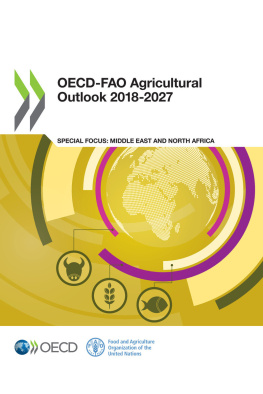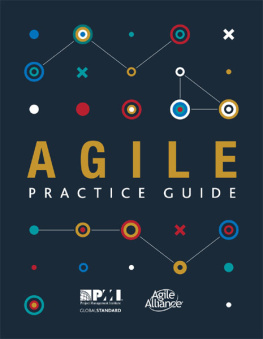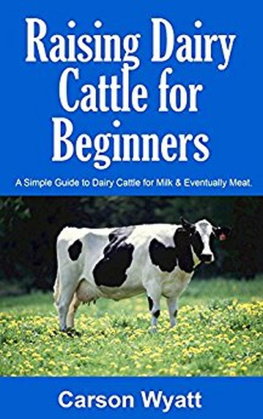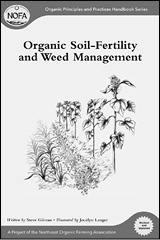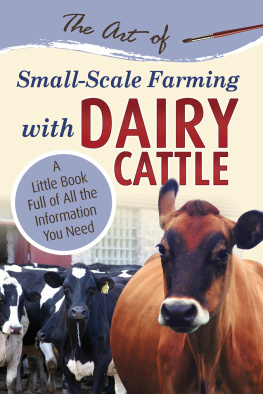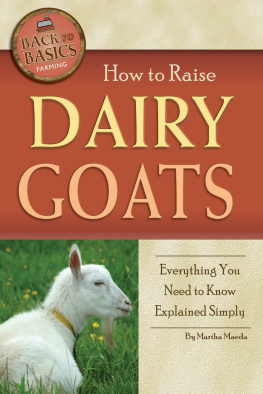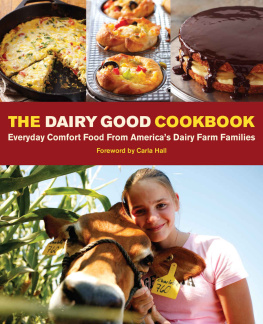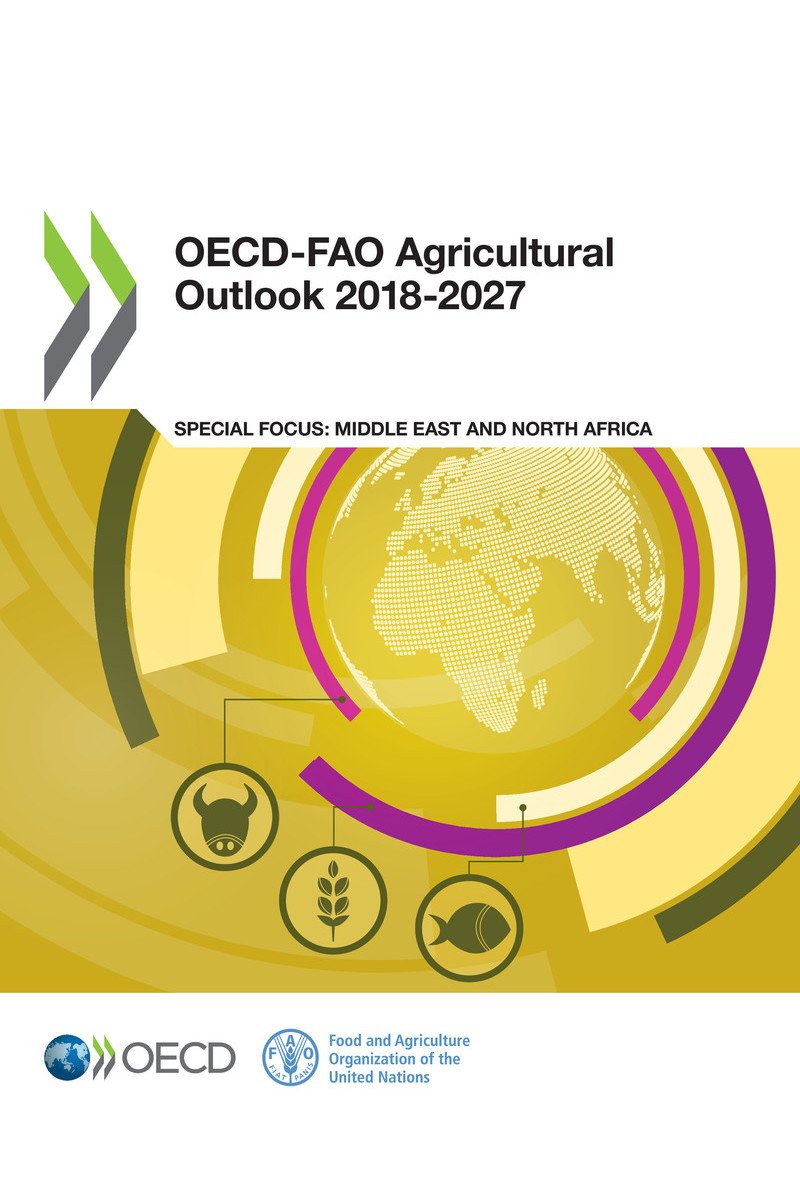OECD-FAO Agricultural Outlook 2018-2027
Please cite this publication as:
OECD/FAO (2018), OECD-FAO Agricultural Outlook 2018-2027 , OECD Publishing, Paris/Food and Agriculture Organization of the United Nations, Rome.
https://doi.org/10.1787/agr_outlook-2018-en
Metadata, Legal and Rights
ISBN: 978-92-64-29721-0 (print) - 978-92-64-06203-0 (pdf) - 978-92-64-30348-5 (HTML) - 978-92-64-30347-8 (epub)
DOI: https://doi.org/10.1787/agr_outlook-2018-en
Annual: OECD-FAO Agricultural Outlook
ISSN: 1563-0447 (print) - 1999-1142 (online)
FAO
ISBN: 978-92-5-130501-0 (Print and PDF)
This work is published under the responsibility of the Secretary-General of the OECD and the Director-General of the FAO. The opinions expressed and arguments employed herein do not necessarily reflect the official views of OECD member countries, or the governments of the FAO members.
This document, as well as any data and any map included herein are without prejudice to the status of or sovereignty over any territory, to the delimitation of international frontiers and boundaries and to the name of any territory, city or area.
The designations employed and the presentation of material in this information product do not imply the expression of any opinion whatsoever on the part of the Food and Agriculture Organization of the United Nations concerning the legal or development status of any country,territory, city or area or of its authorities, or concerning the delimitation of its frontiers or boundaries.
The names of countries and territories used in this joint publication follow the practice of the FAO.
The statistical data for Israel are supplied by and under the responsibility of the relevant Israeli authorities. The use of such data by the OECD is without prejudice to the status of the Golan Heights, East Jerusalem and Israeli settlements in the West Bank under the terms of international law.
The position of the United Nations on the question of Jerusalem is contained in General Assembly Resolution 181(II) of 29 November 1947, and subsequent resolutions of the General Assembly and the Security Council concerning this question.
Photo credits: Cover Original cover concept designed by Juan Luis Salazar. Adaptations by OECD.
Corrigenda to OECD publications may be found on line at: www.oecd.org/publishing/corrigenda .
OECD/FAO 2018
You can copy, download or print OECD content for your own use, and you can include excerpts from OECD publications, databases and multimedia products in your own documents, presentations, blogs, websites and teaching materials, provided that suitable acknowledgement of OECD as source and copyright owner is given. All requests for public or commercial use and translation rights should be submitted to .
Foreword
The Organisation for Economic Co-operation and Development (OECD) and the Food and Agriculture Organization of the United Nations (FAO) have come together for the 14 th year to prepare the OECD-FAO Agricultural Outlook 2018-2027 . This report is enriched by our close collaboration with contributing member country institutions, specialised commodity bodies, and other partner organisations, and has become an annual benchmark that provides a consistent picture of medium-term trends in global agriculture.
By bringing together evidence-based market and policy information from experts across a wide range of countries, the OECD and FAO are supporting our Members in the pursuit of their shared global priorities. This is particularly the case for the Sustainable Development Goals (SDGs), which aim to end hunger, achieve food security, improve nutrition, and promote sustainable agriculture by 2030. Our joint work on agricultural market projections helps to identify and assess opportunities and threats related to the SDG targets and to the commitments made in the UN Framework Convention on Climate Changes 2015 Paris Agreement. Agriculture not only contributes to climate change (the sector still accounts for more than a fifth of all greenhouse gas emissions), but will also be impacted by climate change. So it is fundamental to promote the adaptation of agricultural sectors through sustainable practices that can also mitigate the impacts of climate change.
Global agro-food trade will also play an increasingly important role in ensuring food security, especially for import-dependent regions. An enabling trade policy environment is a crucial condition to achieve the SDGs and make progress towards zero hunger, particularly in the context of climate change. Building on these efforts, Agriculture Ministers convened at the OECD in 2016 and adopted a Declaration on Better Polices to Achieve a Productive, Sustainable and Resilient Global Food System, which places a high priority on policies that underpin competitive, sustainable, productive and resilient farm and food businesses.
This years edition of the Agricultural Outlook includes a special chapter on the Middle East and North Africa (MENA), a region where conflict and political instability have amplified issues of food insecurity and malnutrition. The need for the region to address these challenges, with limited land and water resources, will be further compounded by the expected impact of more frequent extreme climate-related events. We need to improve the resilience and sustainability of food systems in times of conflict, to valorise resources which are becoming ever more fragile and scarce.
Our partners in the G20 and G7 likewise continue to prioritise food security and agricultural issues on their policy agendas. Along with the Agricultural Outlook , the Agricultural Market Information System (AMIS) is part of our wider efforts to provide timely market information to policy makers and global stakeholders. It represents a vital tool that enhances transparency and helps to prevent unexpected price hikes by co-ordinating policy action. AMIS was championed by the G20 and is housed at the FAO with support by numerous international organisations like the OECD.
The challenges we face today cannot be tackled alone. We hope that our collaborative effort on this annual publication will continue to provide governments and all other stakeholders with the evidence base they need to achieve the ambitious and important goals we must meet together.

Angel Gurra
Secretary-General
Organisation for Economic Co-operation and Development

Jos Graziano da Silva
Director-General
Food and Agriculture Organization of the United Nations
Acknowledgements
The Agricultural Outlook 2018-2027 is a collaborative effort of the Organisation for Economic Co-operation and Development (OECD) and the Food and Agriculture Organization (FAO) of the United Nations. It brings together the commodity, policy and country expertise of both organisations and input from collaborating member countries to provide an annual assessment of prospects for the coming decade of national, regional and global agricultural commodity markets. The baseline projection is not a forecast about the future, but rather a plausible scenario based on specific assumptions regarding the macroeconomic conditions, the agriculture and trade policy settings, weather conditions, longer term productivity trends and international market developments.

